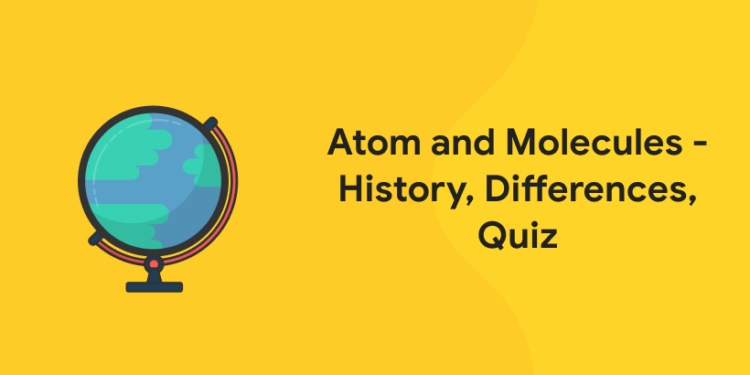Table of Contents
Atoms and molecules are the known as the building blocks of matter. Different types of matter exist around us which are due to the different kinds of atoms and molecules present in them. Atoms are made up of 3 subatomic particles, electrons, protons and neutrons. At the centre of an atom which is the nucleus consists of proton and neutrons while outside the nucleus electrons are present. There are various models and theories proposed by scientists about the structure of an atom by different scientists during their times. This article talks about the history of these models and the characteristics of atom.
Grab study materials to strengthen your GK !!! Register Now !!!
Atoms and Molecules Definition
Atoms are extremely small in size to be seen; hence experiments to find their structure and behavior are conducted with large numbers of them. With the help of these experiments a model of an atom that behaves like the true atom can be found.
Molecules consist of a group of such atoms bound together by covalent (chemical) bonds. Atoms may be portrayed by circle shapes, each of which has a nucleus at the centre (consisting of protons and neutrons), surrounded by one or more concentric circles symbolizing the ‘shells’ or ‘levels’ in which the electrons surrounding the nucleus of the atom are placed. Markings are used to indicate the electron at each level. A molecule is the tiniest thing a substance can be divided into while continuing to be the same substance. It is made up of 2 or more atoms that are bound together by chemical bonding.
Grab study materials to strengthen your GK !!! Register Now !!!
Atom Definition Chemistry
The tiniest particle of an component, which may or may not have an independent existence but always takes place in a chemical reaction is known as an atom. An atom is defined as the tiniest unit that retains the properties of an element. An atom is composed of sub-atomic substances and these cannot be created or destroyed. All atoms of the same material are identical and different materials have different types of atoms. Chemical reactions take place when atoms are rearranged.
Atoms consist of 3 fundamental types of particles namely the protons, electrons and neutrons. Neutrons and protons have more or less the same mass and in opposition to this the mass of an electron is negligible. A proton has a positive charge, a neutron contains no charge and an electron is negatively charged. An atom has equal numbers of protons and electrons and therefore overall an atom has no charge. The nucleus of an atom has protons and neutrons only, and therefore is positively charged. The electrons reside the region of space around the nucleus. Therefore, most of the element’s mass is concentrated inside its nucleus.
Attempt free GK Mock Test! Download Entri App!
The nucleus is the centre of the atom. The nucleus contains neutrons and protons that give an atom its weight and positive charges. A neutron carries no charge but has a mass of 1 unit. A proton has a single positive charge and also has a mass of 1 unit, The atomic number of a material is equal to the number of protons or positive charges inside the nucleus. The atomic weight of an element is obtained by calculating the total number of protons and neutrons in the nucleus. An electron carries a single negative charge. If an atom of an element is to have no charge, it must have the same amount of electrons as protons. These electrons are placed in orbits around the nucleus of the atom like the layers in an anion.
What are Atoms made of?
An atom is composed of 3 particles, namely, neutrons, protons and electrons with hydrogen as an exception without neutrons.
- Every atom has a nucleus that is surrounded by one or more electrons around it.
- The nucleus has usually a similar number of protons and neutrons which are together known as nucleons.
- The protons have positive charge, electrons have negative charges and neutrons are neutral.
What is a Molecule?
Molecule Definition
A molecule is defined as the smallest part of a compound that has the chemical properties of the compound.
Molecules are made up of a collection of atoms. Describing the structure of an atom, an atom is also sub-divided into smaller units. Protons, electrons, and neutrons are sub-particles of an atom. The protons and neutrons are present inside the nucleus of the atom and electrons revolve around this nucleus.
Protons are positively charged materials whereas electrons are negatively charged particles. Neutrons do not have any charge. So we say that the nucleus is positively charged as it contains protons. The nucleus is the major mass at the centre of an atom. Atoms are largely empty.
Each element has a certain atomic number. The atomic number of an element is characterized as the number of protons present in its nucleus. It is represented by Z.
When we talk of the mass of atoms, the mass of their particles is taken into consideration. Electrons have minimal mass. Thus the mass of an atom can be obtained by adding the masses of protons and neutrons. The mass number is represented as A.
A molecule is the smallest part (particle) of a compound having the physical and chemical properties of that compound. This does not mean that molecules can not be broken down into further parts, e.g. the atoms from which they are formed or the fragments of the molecule, each have several atoms or parts of atoms.
A molecule is defined as the tiniest unit of a compound that contains the chemical properties of the compound. Molecules are made up of collection of atoms. Employing the structure of an atom, an atom is also further divided into smaller units. Proton, electrons, and neutrons are sub division of an atom. The protons and neutrons are present inside the nucleus of the atom and electrons revolve around the nucleus.
Grab study materials to strengthen your GK !!! Register Now !!!
Examples of Molecules
A molecule is a collection of 2 or more atoms that make up the tiniest recognisable unit into which a pure material may be split while maintaining its property and chemical characteristics. Some e.g of molecules are:
- H2O (water)
- N2 (nitrogen)
- O3 (ozone)
- CaO (calcium oxide)
- C6H12O6 (glucose, a type of sugar)
- NaCl (table salt)
Forces between Atoms and Molecules
The simplest forces that exist between atoms are those which originate as a result of electron transfer. A simple e.g is that of say sodium fluoride. The sodium atom has a nuclear charge of plus eleven, with two electrons in the K shell, eight in the L shell and one in the M shell. The fluorine atom has a nuclear charge of nine with two electrons in the K shell and seven in the L shell.
The outermost electron in the sodium atom may jump readily to the fluorine atom; both atoms now will have a complete shell but the sodium now has a net charge of plus one and the fluorine a net charge of minus one. These ions, therefore, attract each other by direct coulombic interaction. The force between them is strong it is given as x-2, where x is the distance between the ions, and it acts in the direction of the line joining them.
Differences between Atoms and Molecules
Given below are the differences between atoms and molecules.
| Factor | Molecules | Atoms |
| Definition | 2 or more atoms chemically bonded together. | Most fundamental and tiniest part that can exist of an element. |
| Example | Oxygen – O2
Phosphorus – P4 Sulphur – S8 Water – H2O |
Oxygen – O
Phosphorus – P Sulphur – S Hydrogen – H |
| Structure | Combination of 2 or more atoms. | The tiniest particle with properties of an element. |
| Stability | Molecules are formed to obtain stability. | An atom may not be stable in nature due to the presence of electrons in the outermost shells. |
| Constituent Particles | 2 or more atoms of the same or different elements | Protons, Electrons and Neutrons |
| Reactivity | Compared to an atom, the level of reactivity is less as some valence points are filled by electrons of combined elements. | Except for the noble elements, atoms of all elements shows a particular level of reactivity. |
Grab study materials to strengthen your GK !!! Register Now !!!
History of Atomic Theory
The different atomic theories that were proposed from the end of 18th century are discussed below:
Dalton’s Atomic Theory
- The matter is consists of minute particles called
- Atoms are indivisible particles that can neither be destroyed nor created through chemical reactions.
- All atoms of a single element will have identical chemical properties and mass whereas, atoms of distinct elements will have different chemical properties and masses.
- Atoms combine to form compounds in a ratio of small whole numbers.
Plum Pudding Model and Rutherford Model
- The model tried to explain 2 properties of atoms then known: that electrons are negatively-charged particles and that atoms have no net electric charge or is neutral.
- According to this Model, an element consists of small spheres where the positive charge is spread in a regular manner throughout the volume of sphere called pudding and the negatively charged particles or Electrons form the Plums which are apportioned as point charges on the shells.
Bohr Model of the Atom
- According to this model electrons orbit the nucleus in orbits that have a predefined size and energy.
- The energy of the orbit depends on its size. The minimal energy is found in the smallest orbit.
- Radiation is absorbed or emitted when an electron jumps from one orbit to another.
Quantum Atomic Theory
- The energy of the negatively charged particle or an electron is quantized i.e. an electron can only have certain specific whole values of energy.
- The quantized energy of an electron is the result of wave like properties of electron.
- As per Heisenberg’s Uncertainty principle, the exact position and momentum of an electron cannot be found.
Atom and Molecules: Quiz
1. Who had proposed the model of an atom in 1903, due to which electrons and protons came to be known?
a) J.J. Thomson
b) Rutherford
c) Goldstein
d) Dalton
Ans. (a) J.J Thomson
2. ________ is the model of an atom which is similar to a Christmas pudding.
a) Dalton’s Model
b) Thomson’s model
c) Rutherford model
d) None of the above
Ans. (b) Thomson’s model
3. The existing concept of the structure of an atom is given by _____________ .
a) Goldstein
b) Niels Bohr
c) J.J. Thomson
d) Rutherford
Ans. (c) Niels Bohr
4. ________________ is the atom in which the nucleus of that atom does not contain any neutrons.
a) Hydrogen
b) Phosphorous
c) Sodium
d) Oxygen
Ans. (a) Hydrogen
5. Which model is not able to justify the stability of an atom?
a) Thomson’s Model
b) Bohr’s Model
c) Rutherford’s Model
d) None of the above
Ans. (c) Rutherford’s Model
Grab study materials to strengthen your GK !!! Register Now !!!
6. On passing high voltage electricity through gases at very low pressure resulted in the discovery of _______ according to Goldstein’s experiment.
a)Neutron
b)Electron
c)Proton
d)Nucleus
Ans. (c) Proton
7. ______________ discovered electron.
a) Goldstein
b) J.J.Thomson
c) D. James Chadwick
d) Niels Bohr
Ans. (d) Niels Bohr
8. In 1932 ___________ had discovered neutron.
a) Rutherford
b) J.J Thomson
c) James Chadwick
d) Goldstein
Ans. (c) James Chadwick
9. _______________ describes that there is no change in the energy of electrons as long as they keep revolving in the same energy level and atoms remains stable.
a) J.J Thomson Model
b) Bohr’s Model
c) Rutherford Model
d) None of the above
Ans. (b) Bohr’s Model
10. _________ is the correct electronic configuration of sodium.
a) 2,8,1
b) 8,2,1
c) 2,1,8
d) 2,8,2
Ans. (a) 2,8,1
Grab study materials to strengthen your GK !!! Register Now !!!
I hope this article was helpful. The key point to clear an exam lies in methodical and planned preparation. If you are a candidate who wants to pursue your dream career and looking for a good start, our Entri app has got it covered for you. Our team will help you with content and insights related to the topics of your concern. Subscribe to our app today and enrol yourself into various programmes our app offers. Tune in to the app to stay updated regarding various aspects of the subject you are interested in. Feel free to post any queries and doubts in the comment section. We will try our best to reach out. Push away all those self-doubts and negative thoughts. Try to have a clear vision. Ask yourself why you want this. Focus on the good and work hard. There is a saying that goes like this, Get up and set your shoulders to the wheel-how long is life for you? as you have come to this world leave some mark behind or where is the difference between your trees and stones they too come into existence decay and die. Each day is a precious gift bestowed upon us so make it count. Work on yourself. Stop procrastinating. Today is the day, hope for the best. Good luck.














